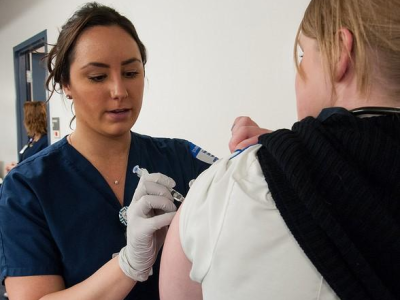Influenza activity became more widespread last week in the United States, and flu was responsible for four pediatric deaths, the Centers for Disease Control and Prevention (CDC) reported today.
Eight states—Arizona, Arkansas, Illinois, Maryland, New Mexico, Tennessee, Utah, and Virginia—and Puerto Rico reported high levels of influenza-like illness (ILI), up from six states reporting high activity the week before. New York City and nine states reported moderate flu activity.
Flu cases were geographically widespread in 33 states and Puerto Rico, up from 21 states the week before. States in the Southeast continue to report regional activity.
Outpatient clinic visits attributed to ILI stayed at the proportion of 3.2% reported the week before, which is above the national baseline of 2.1%. ILI-related clinic visits varied regionally, accounting for 1.2% to 4.8% of all visits.
The proportion of respiratory specimens that tested positive for flu in clinical laboratories increased last week, reaching 17.6% (3,803 of 21,615 specimens), up from 13.8% a week earlier.
Hospitalizations and deaths
Four pediatric deaths were reported by the CDC, raising the total of flu-related pediatric deaths this season to 18. Deaths were attributed to H1N1 (2 deaths), influenza B (1), and an uncharacterized influenza A (1).
The total count of flu-related hospitalizations for the season reached 7.8 per 100,000 population last week, up from the cumulative count of 5.8 per 100,000 the week before, the CDC said.
The highest hospitalization rate occurred in those 65 and older (21.3 per 100,000), up from 16.7 per 100,000 population the week before. Of 56 hospitalized women of childbearing age, 15 were pregnant.
The proportion of deaths due to pneumonia and influenza was at 7.4% in the 122 Cities Mortality Reporting System, which is above the system's epidemic threshold of 7.2%. The proportion reported by the National Center for Health Statistics Mortality Surveillance System was 6.7%, which is below that system's epidemic threshold.
Circulating strains
No changes in proportions of circulating viruses were reported, with influenza A viruses still outnumbering B viruses by 78% to 22% among tested specimens last week, the CDC said. H1N1 accounted for 89.4% of the type A isolates that were characterized, and H3 viruses made up 9% of type A isolates.
The CDC said the circulating viruses continue to match well with the strains used in this year's flu vaccine. During this season, only two H1N1 samples have shown resistance to the antiviral oseltamivir, and two H1N1 samples were resistant to peramivir.
See also:
Mar 4 CDC FluView report
Feb 26 CIDRAP News story on previous FluView report




















